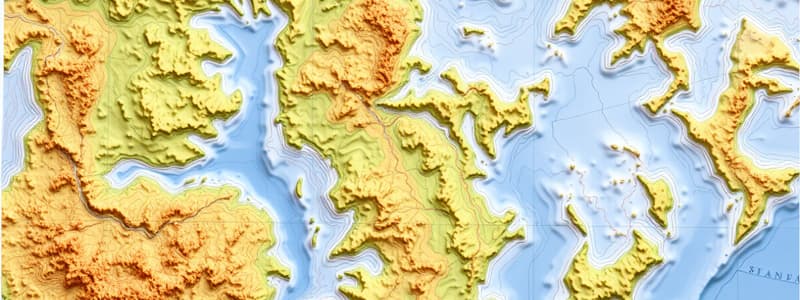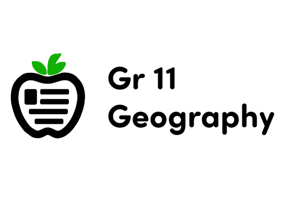Podcast
Questions and Answers
Examples of topographic map scales are 1:250,000, 1:125,000, 1:62,500 and 1:24,000. Of these listed, which is the largest scale?
Examples of topographic map scales are 1:250,000, 1:125,000, 1:62,500 and 1:24,000. Of these listed, which is the largest scale?
- 1:24,000 (correct)
- 1:125,000
- 1:62,500
- 1:250,000
Examples of topographic map scales are 1:250,000, 1:125,000, 1:62,500 and 1:24,000. Of these listed, which is the smallest scale?
Examples of topographic map scales are 1:250,000, 1:125,000, 1:62,500 and 1:24,000. Of these listed, which is the smallest scale?
- 1:24,000
- 1:125,000
- 1:62,500
- 1:250,000 (correct)
On a map with a scale of 1:24,000, two points that are 3.4 inches apart would actually be (in feet)
On a map with a scale of 1:24,000, two points that are 3.4 inches apart would actually be (in feet)
6,800 feet apart
On a map with a scale of 1:62,500, two points that are 4 centimeters apart would actually be (in meters)
On a map with a scale of 1:62,500, two points that are 4 centimeters apart would actually be (in meters)
If you have a map that has a scale of 1:125,000 and the '1' refers to 1 inch, then the '125,000' must be equal to:
If you have a map that has a scale of 1:125,000 and the '1' refers to 1 inch, then the '125,000' must be equal to:
A scale on which one inch equals 1000 feet would be written on a map as which of the following ratio scales?
A scale on which one inch equals 1000 feet would be written on a map as which of the following ratio scales?
For the following map scales, which would cover a larger area? 1:120,000 ; 1:62,500 ; 1:24,000 ; 1:12,000
For the following map scales, which would cover a larger area? 1:120,000 ; 1:62,500 ; 1:24,000 ; 1:12,000
For the following map scales, which would show greater detail (such as buildings and other structures)? 1:120,000 ; 1:62,500 ; 1:24,000 ; 1:12,000
For the following map scales, which would show greater detail (such as buildings and other structures)? 1:120,000 ; 1:62,500 ; 1:24,000 ; 1:12,000
Map relief is defined by
Map relief is defined by
Which of the following verbal map scales would cover the smallest area? 1in=10,000ft; 1in=300ft; 1cm=10,000cm; 1cm=300cm
Which of the following verbal map scales would cover the smallest area? 1in=10,000ft; 1in=300ft; 1cm=10,000cm; 1cm=300cm
The verbal scale of 1 in = 3.5 miles would become which of the following ratio scales?
The verbal scale of 1 in = 3.5 miles would become which of the following ratio scales?
What is the equation for a river gradient?
What is the equation for a river gradient?
Flashcards are hidden until you start studying
Study Notes
Topographic Map Scales
- Largest scale among the given examples is 1:24,000, indicating higher detail over a smaller area.
- Smallest scale among the examples is 1:250,000, covering a larger area with less detail.
- Scale impacts the representation of distances; for a 1:24,000 map, 3.4 inches equals 6,800 feet in reality.
- On a 1:62,500 map, a distance of 4 centimeters represents 2,500 meters.
Understanding Scale Units
- A scale of 1:125,000 means that "1" inch on the map corresponds to 125,000 inches in reality.
- A map scale where one inch equals 1,000 feet is denoted as 1:12,000.
Area and Detail Representation
- Among various scales, 1:120,000 covers the largest area, providing less detail than finer scales.
- Conversely, 1:12,000 shows greater detail, useful for identifying structures like buildings.
Map Relief and Area Coverage
- Map relief is defined as the change in elevation between the highest and lowest points represented.
- The verbal scale of 1 in = 3.5 miles translates to a ratio scale of 1:18,480.
Comparing Scales
- Between the verbal scales 1in=10,000ft, 1in=300ft, 1cm=10,000cm, and 1cm=300cm, the smallest area covered is represented by 1cm=300cm.
River Gradient
- The specific equation for a river gradient was referenced but is not provided herein.
Studying That Suits You
Use AI to generate personalized quizzes and flashcards to suit your learning preferences.




